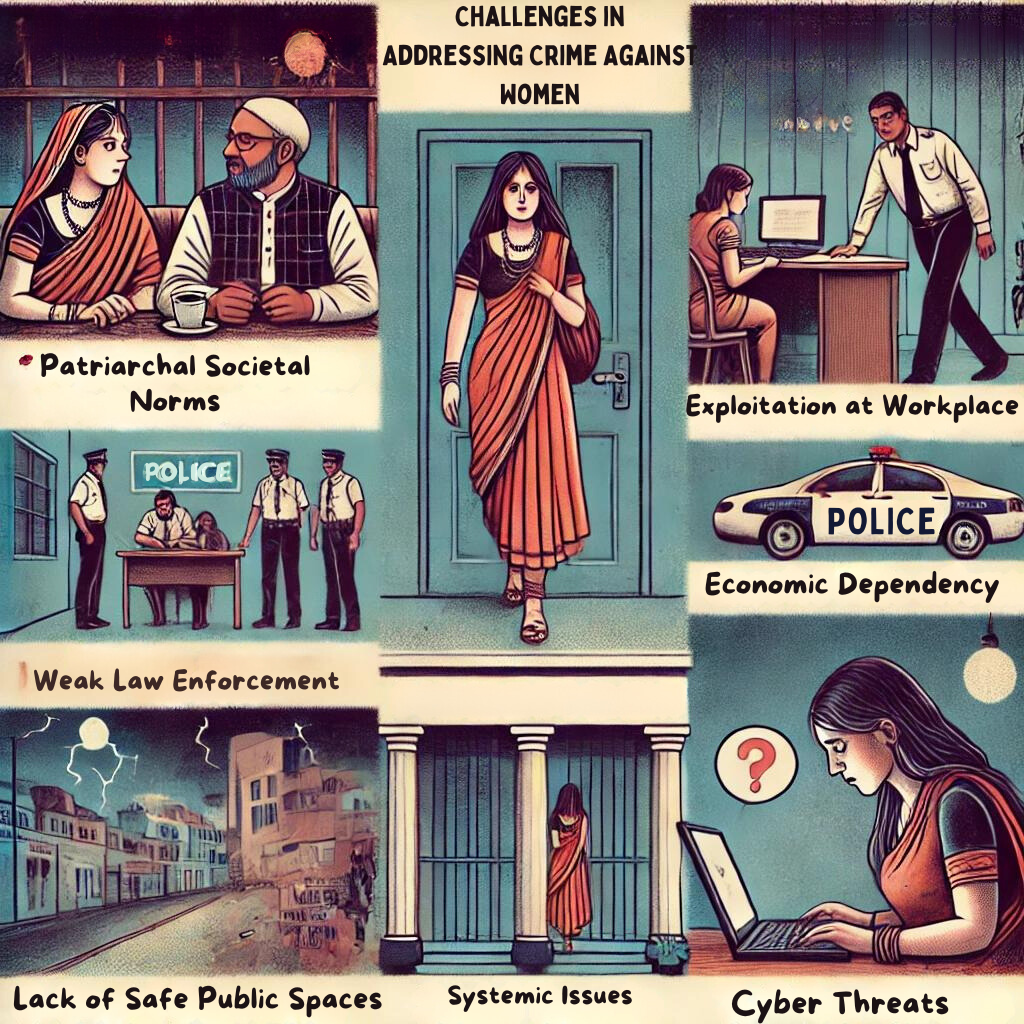The safety of women in India remains a serious concern, as highlighted by the brutal rape and murder of a young doctor in Kolkata. This tragic incident exposes Women’s Safety in India. Despite various laws and growing awareness, crimes against women, including domestic violence, sexual assault, and dowry-related offenses, continue at alarming rates. Urgent reforms are needed to enforce stricter penalties and expedite trials. A multifaceted approach involving community engagement, enhanced support systems, and comprehensive data analysis is essential to creating a safer environment for women.
| GS Paper | General Studies II |
| Topics for UPSC Prelims | Crime Against Women, Gender Equality, National Crime Records Bureau’s Annual Reports, Sexual Harassment At Work, Child Marriage, Dowry System, Vishakha Guideline, Supreme Court, Domestic Violence, Acid Attacks On Women, Pre-Natal Diagnostic Techniques Act 1994, Article 21, Nirbhaya Fund, One Stop Centres, Mahila Police Volunteers, Investigation Tracking System For Sexual Offences, Justice Verma Committee, Representation of Women in Law Enforcement and the Judiciary. |
| Topics for UPSC Mains | Significance of Government Policies & Interventions in Addressing Issues Related to Women. |
Origin of the Article
This editorial is based on ‘Kolkata rape and murder: When the law fails women‘ which was published in The Indian Express on August 21, 2024. The article discusses the urgent need for legal reforms to better protect women in India.
Relevancy for UPSC Students
For UPSC students, understanding issues related to women’s safety is crucial. This topic is relevant to the General Studies papers, especially GS Paper 1 and GS Paper 2, which cover social empowerment, gender issues, and government policies. Knowledge of these issues can aid in essay writing, policy analysis, and preparation for interviews.

Why in News
The brutal rape and murder of a young doctor in Kolkata have once again highlighted the persistent failures of India’s legal system to protect women. This tragic incident underscores the urgent need for stringent legal reforms, expedited trials, and effective enforcement mechanisms, making it a critical topic for UPSC aspirants. Previous UPSC exams have frequently addressed issues related to gender equality, crime against women, and government policies. Thus, reflecting the ongoing relevance of this issue for civil service examination preparation.
Statistics on Women’s Safety
Crimes against women in India have seen a disturbing rise, as highlighted by the National Crime Records Bureau’s (NCRB) 2022 report. The data reveals a significant increase in incidents, necessitating immediate and effective measures to ensure women’s safety and security across the nation.
Overall Statistics
The NCRB’s 2022 report documents a total of 4,45,256 cases of crimes against women. Thereby, reflecting a 4% increase from the previous year. This translates to approximately 51 FIRs being filed every hour. The crime rate per lakh population stood at 66.4, and the charge sheet filing rate was 75.8%.
Types of Crimes
| Crime Category | Percentage (%) | Number of Cases (if available) |
|---|---|---|
| Cruelty by Husband or Relatives | 31.4 | – |
| Kidnapping and Abduction | 19.2 | – |
| Assault with Intent to Outrage Modesty | 18.7 | – |
| Rape | 7.1 | – |
| Sexual Harassment at Workplaces | – | Over 400 annually since 2018 |
| Juveniles Implicated in Rape | – | 86 |
| Juveniles Implicated in Outraging Modesty | – | 68 |
State-wise Data
Delhi reported the highest crime rate against women, with 144.4 incidents per lakh population and 14,247 cases in 2022. Uttar Pradesh registered the most cases, totaling 65,743 FIRs, followed by Maharashtra, Rajasthan, and West Bengal.
Challenges in Addressing Crime Against Women
The challenges in addressing crimes against women are multifaceted, encompassing societal norms, legal inefficiencies, and infrastructural shortcomings. These obstacles hinder the effective implementation of protective measures and justice delivery.
Patriarchal Societal Norms
Patriarchal values perpetuate gender-based violence, often reinforced by local entities like Khap Panchayats. These norms undermine women’s autonomy and contribute to a culture of violence.
Exploitation at Workplace
Despite the Sexual Harassment Act of 2013, workplace harassment remains prevalent. NCRB data indicates over 400 annual cases, and reports like the Justice Hema Committee highlight severe exploitation in industries such as Malayalam cinema.
Lack of Safe Public Spaces
Inadequate public safety measures, such as poorly lit streets and unreliable public transport, increase women’s vulnerability to crime. The 2012 Delhi gang rape is a tragic example of the dangers posed by unsafe public spaces.
Insufficient Infrastructure and Resources
Many areas lack the necessary infrastructure, including functional police stations, forensic labs, and emergency services, to effectively handle and investigate crimes against women.
Weak Law Enforcement and Judicial Systems
Delays and inefficiencies in the legal system, as seen in the Nirbhaya case, hinder justice delivery. Low conviction rates, particularly in rape cases, further exacerbate the problem.
Systemic Issues
Corruption within law enforcement and the legal system, exemplified by cases like the Badlapur sexual assault, impedes the proper handling of crimes, often resulting in delayed FIR filings.
Social Stigma and Victim Blaming
Victim-blaming attitudes discourage reporting of crimes. Survivors often face stigma and blame from communities and officials, deterring them from seeking justice.
Gender Inequality & Cultural Attitudes
Disparities in education, employment, and societal roles, along with practices like child marriage and dowry, contribute to women’s vulnerability to violence and exploitation.
Lack of Education and Awareness
Limited access to education and awareness about legal protections leaves many women unprotected and reluctant to report crimes or seek justice.
Economic Dependency
Financial dependence on male family members traps women in abusive situations, particularly in lower-income families, making it difficult for them to escape.
Domestic Violence
Domestic violence often escalates to more severe crimes, including sexual assault and murder, highlighting the need for comprehensive protective measures.
Technological and Cyber Threats
Online harassment, including cyberbullying, stalking, and non-consensual image sharing, is on the rise, necessitating updated legal and technical solutions.
Substance Abuse
Substance abuse, particularly involving alcohol and drugs, is linked to increased violence against women, indicating the need for integrated intervention strategies.
False Allegation
False rape accusations undermine the credibility of genuine victims, deterring reporting and complicating the pursuit of justice for real cases.

Various Frameworks and Initiatives
To combat crimes against women, India has established several legal frameworks and government initiatives, aiming to provide comprehensive protection and justice for women.
Legal Framework
Key laws include the Sexual Harassment Act of 2013, the Nirbhaya Act, and the POCSO Act, among others. These laws define offenses, set penalties, and establish mechanisms for victim support and protection.
Judicial Interventions
Landmark Supreme Court judgments, such as Joseph Shine vs. Union of India and the Nirbhaya Case, have significantly shaped women’s rights, setting precedents and guidelines for addressing gender-based violence.
Government Initiatives
Initiatives like the Nirbhaya Fund, One Stop Centres, and Beti Bachao Beti Padhao aim to enhance women’s safety and empowerment. Programs focus on providing emergency support, shelter, and awareness, leveraging technology and community involvement.
Way Forward
Addressing the pervasive issue of crimes against women requires a multifaceted approach, focusing on legal, societal, and technological strategies to enhance protection and reduce crime rates.
Strengthening Implementation
Effective implementation of existing laws requires better training for law enforcement, streamlined judicial processes, and accountability measures.
Fast-Track Courts
Establishing fast-track courts for severe cases, as recommended by the Justice Verma Committee, can expedite justice delivery and increase women’s representation in the judiciary.
Gender Sensitization
Comprehensive gender sensitization programs in schools, workplaces, and communities can address the root causes of gender-based violence and discrimination.
Enhanced Police Training
Specialized training for police officers on evidence collection, victim support, and case documentation is crucial, with initiatives like SHE Teams serving as models.
Improved Survivor Support Systems
Expanding support systems for violence survivors, including counseling, rehabilitation, and economic assistance, can help them rebuild their lives.
Economic Empowerment
Promoting women’s economic independence through education, skill development, and employment opportunities can reduce their vulnerability to violence.
Technology Utilization
Leveraging technology for crime reporting and tracking, such as mobile apps and AI systems. Thereby, enhance the efficiency and effectiveness of protective measures.
Increased Women’s Representation
Boosting women’s representation in law enforcement and the judiciary can bring diverse perspectives and improve the handling of gender-based violence cases.
Regular Impact Assessments
Periodic evaluations of policies and schemes can assess their effectiveness and inform necessary adjustments for better outcomes.
Media Responsibility
Encouraging responsible media reporting on crimes against women, focusing on systemic issues rather than sensationalism. This can foster more informed and supportive public discourse.
Recent Instructions of Union Ministry of Health and Family Welfare
In light of a tragic incident in Kolkata, the Union Ministry of Health and Family Welfare has issued directives to enhance security measures in hospitals. These measures aim to ensure the safety of healthcare professionals and patients.
Key Recommendations
The ministry’s 12 key recommendations include installing high-resolution CCTV cameras, setting up emergency response control rooms, and securing duty rooms and transport for female health professionals. Additionally, well-trained security personnel, restricted access to sensitive areas, and comprehensive emergency plans are emphasized.
PESTEL Analysis
| Political: India has established several laws and initiatives aimed at enhancing women’s safety, like the Nirbhaya Fund and the Sexual Harassment Act of 2013. However, the political will to enforce these laws effectively remains inconsistent, affecting their overall impact. Economic: The economic dependency of women on male family members often traps them in abusive situations. Promoting women’s financial independence through education and employment is crucial. This also ties into economic strategies that could be strengthened by better funding and support for women-centric economic initiatives. Social: Deep-rooted patriarchal norms and social stigma related to reporting crimes against women hinder progress. Educational campaigns for gender sensitization and breaking down these societal barriers are essential for long-term change. Technological: Utilizing technology like mobile apps for crime reporting and AI for data analysis could enhance responsiveness and prevention measures. However, cyber threats and online harassment are growing concerns that require updated legal frameworks and technological solutions. Environmental: While not directly mentioned, the environmental aspect can be related to the safe access to public spaces. Improving infrastructure such as street lighting and public transport can reduce the vulnerability of women in these areas. Legal: Weak law enforcement, delays in trials, and low conviction rates undermine the effectiveness of existing laws. Implementing fast-track courts and enhancing police training are recommended to improve the judicial response to crimes against women. |
Conclusion
The persistent challenge of crimes against women in India demands a comprehensive, multi-pronged approach to address this deeply entrenched societal problem. The grim statistics presented in the NCRB report serve as a sobering reminder that more needs to be done to ensure the safety and dignity of women in India. Strengthening the implementation of existing laws, enhancing gender sensitization programs, and providing comprehensive support services for survivors are crucial steps. Ultimately, the fight against crimes targeting women in India requires a sustained, concerted, and compassionate response from all corners of society. By working towards a future where women’s rights and safety are inviolable, India can make meaningful progress toward achieving true gender equality and social justice.


